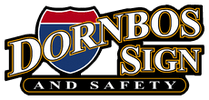The History of Street Signs
Posted by Jeffery Dornbos on 31st Mar 2015
You pass them every day, they play an integral role in providing communication and traveling safety, but have you ever wondered how street signs came to be. Allow Dornbos to walk you down memory lane and share a topic that we care about deeply.
This is the history of street signs.
Street Sign History
Street signs can be traced back centuries to the day when the Romans were beginning to build cities and stretch their empire out far from Rome. These first street signs were very rudimentary stone structures, but they provided valuable information including direction and distance.
Next came the multidirectional signs at intersections during the Medieval period. In the middle ages many towns and cities began to spring up in Europe and the paths to these centers intersected. At the intersections wooden signs would indicate which path would take you to which city.
The late 1800s brought about an invention that offered a novel transportation mode – the bicycle. In the 1870s and 1880s bicycles became so common that clubs were formed. These clubs put together a wide scale effort to erect street signs made mostly of cast iron that not only gave direction and distance but also warnings of hazards ahead.
The advent of automobiles a few decades later posed a whole new set of logistics and increased need for road signs that provided warnings and improved driver safety. Italy was the first to create a complex sign system that could be used by car drivers in 1895. By 1909 nine European countries were using standardized pictorial signs.
As travel between countries has increased so has the need for global communication and cooperation. In 1968 the Vienna Convention on Road Signs and Signals was founded to help standardize street signs in an effort to make the roads safer. The convention, which currently has 52 member nations, has established 8 categories of signs.
Though many countries recognize the convention many others have developed their own protocols for street signs, including the U.S. Here in the states the governing regulations for road signs is the U.S. Manual on Uniform Traffic Control Devices.
History of Street Signs in Modern America
America is synonymous with everything automobile-related. In the early 1900s the roadways were still very rural and rough. Road maintenance and signage was left up to local automobile clubs. This inherently had problems because there was no uniformity and often signs promoted the club as much as they provided information.
It wasn’t until the 1920s when various state governments stepped in that street signs began to gain some clarity. After a series of reports on improvements that could be made, the Manual and Specifications for the Manufacture, Display, and Erection of U.S. Standard Road Markers and Signs was published in 1927. This was the beginning of street sign standardization in the U.S.
Today, all states must have a highway safety program and adhere to signage standards put in place by the U.S. Department of Transportation.
Types of Street Signs Used Throughout History
Milestones - Markers that indicated miles along a road were first used by the Romans. Originally they were made of some sort of stone (hence the name), however there once was a “Golden Milestone” in the middle of Rome, which signified the center of the empire.
Fingerposts – Fingerposts are single posts with multiple signs pointing in different directions. They are mainly found at intersections in Europe.
Pictorial Signs – These signs use pictures instead of words, thus eliminating language barriers. Pictorial signs were first used in Europe, but now they are commonly found all over the world.
Traffic Lights – The rise of cars created the need for a new type of sign that would control traffic flow at intersections. Thus, the traffic light was born. Though the first electric traffic light was created in the U.S. in 1912, the very first traffic light was a gas-powered version that was used in 1868 in London.
Street Signs Today
Technology has helped us make huge advances in all facets of life, including our road signs. Some of the most notable achievements include:
- Use of reflective material so that signs are visible 24 hours a day.
- Traffic lights that use sensors to control the flow of cars more effectively.
- Construction materials that can better withstand the elements, such as rust-free aluminum.
From the first highway systems of the Romans to today’s highly populated inner city streets, road signs play just as significant a role in our daily lives now as they did in the past.



